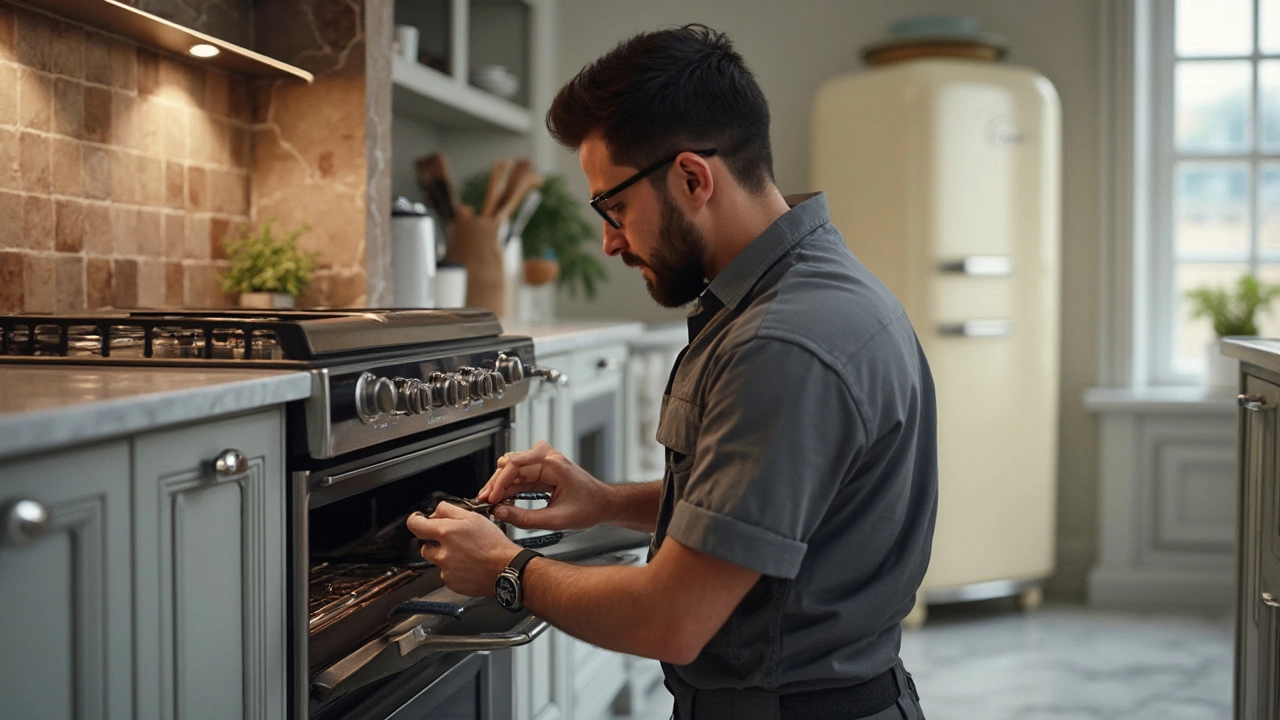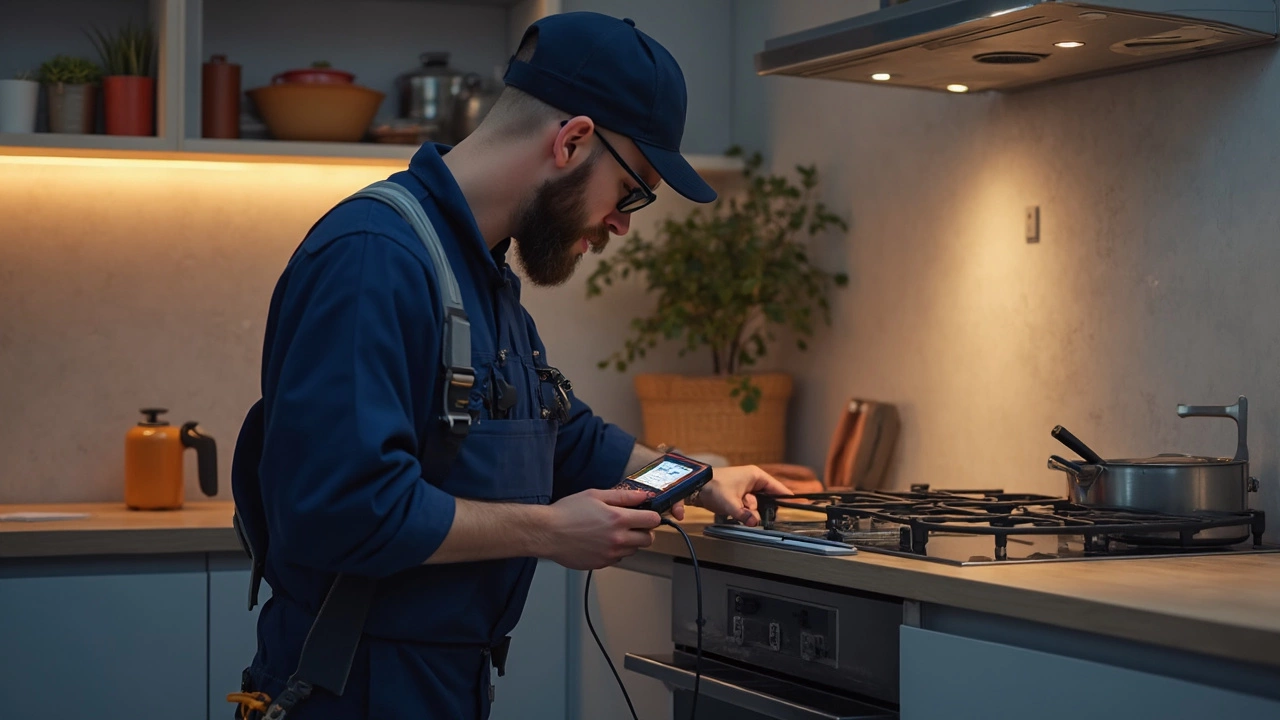Electric ovens—every home chef's trusty companion. But when these gadgets throw a tantrum, fixing them isn't always straightforward. So, can an electrician step in to save your baked goods from doom? Absolutely. Electricians are pros at handling all things electrical, including many of the issues that might plague your oven.
First off, let's talk about what goes wrong. Electric ovens mostly run like a charm, until they don't. You might find the oven not heating up, or the temperature's never quite right. Sometimes, you notice the oven's light isn't working, or maybe there's that mysterious, worrying smell.
If that sounds familiar, you might be wondering if you should dial up a specialist or if a good electrician can tackle these problems. Well, electricians are your go-to for electrical connections, wiring glitches, and sometimes even replacing heating elements and thermostats. They know where the wires go and how much juice they need to keep everything humming along safely.
- Understanding Electric Oven Components
- Common Electric Oven Problems
- When to Call an Electrician
- DIY Tips and Safety Precautions
Understanding Electric Oven Components
Sifting through the parts of an electric oven might feel overwhelming at first—like opening up a puzzle you didn't sign up for. But don’t sweat it. Getting a grip on these components can make a world of difference when something goes awry.
Heating Elements
At the heart of it all are the heating elements. You've likely encountered the glowing orange or red strips inside your oven. These mighty parts are what actually cook your food. A top element might be for broiling while the bottom one usually handles the baking. If your oven doesn't get hot enough, or heats unevenly, these could be the culprits.
Thermostat
This little gadget is crucial. It tells the oven how hot to get and then cuts the power once it reaches the desired temperature. If your food's coming out raw or overdone, the thermostat might be on the fritz.
Control Panel
Now, not every oven has a flashy control panel. But if yours looks like a spaceship control deck, that’s your control panel. It manages temperature settings and timers, and a malfunction could make setting the dials tricky.
Wiring
The veins of your electric oven. Proper wiring ensures that electricity flows just right to various components. If your oven randomly shuts off, or there's a burning smell, this could be a warning sign of faulty wiring. That's when calling an electrician might be your best bet.
The Oven Door and Seal
It seems basic, but these parts are as crucial as the rest. Without a tight seal, heat escapes, leading to uneven cooking. A simple adjustment or replacement of the seal can solve a lot of baking woes.
Breaking down these components not only puts you in the driver's seat during repairs or when chatting with an electrician, but it’s also handy for those casual dinner parties when someone throws shade at your slightly burnt lasagna.
Common Electric Oven Problems
Electric ovens might look sturdy, but when things go south, they can leave you scratching your head. Let's walk through some common hiccups you might face and how these can be tackled. Knowing these specific issues makes it easier to decide if a electrician or a specialist is needed.
1. The Oven's Not Heating Up
You set the temperature, but nothing happens. Often, this is a result of a faulty heating element or bad wiring. Sometimes, it could be as simple as a blown fuse. In such cases, a qualified electrician can test and replace the element or address any electrical issues causing the problem.
2. Uneven Cooking
If your roast looks perfect on top but remains uncooked underneath, uneven cooking could be the culprit. This usually means the thermostat or the oven’s temperature sensor is on the fritz. Calibration might be off, or the sensor could simply need replacement.
3. Oven Door Won't Shut Properly
Nothing's more frustrating than a door that won’t shut when you’re getting ready to bake. Check for obstructions inside the hinge area. If everything looks clear, the door seal or hinge itself might need replacement.
4. Oven Light Isn't Working
Yes, it's usually just a bulb issue. However, if changing the bulb doesn’t do the trick, there might be a deeper wiring problem. Electricians can diagnose whether there's an electrical fault in the socket.
5. Strange Odors or Smoke
No one wants an oven belching smoke without a fire. Common causes include food lodged in nooks or, worse, electrical components overheating. Ensure elements are clean, and call a pro if you suspect anything beyond leftovers causing the odor.
Quick Troubleshooting Tips
- Always start by checking the power supply. Make sure the oven is plugged in and the socket is working.
- Inspect circuit breakers to ensure they haven’t tripped.
- Use a multimeter to check the continuity of heating elements if you're handy with tools.
By understanding these common problems, you can better diagnose and react swiftly. Sometimes a trusty electrician is just what you need to set things straight.

When to Call an Electrician
You're in the middle of cooking your favorite meal, and suddenly the oven stops working. Panic ensues, but don't sweat it just yet. Knowing when to call an electrician for your electric oven repairs can save time, money, and a whole lot of stress.
Electrical Issues and Wiring Problems
If your electric oven isn't turning on or fails to maintain temperature, it could be due to a wiring problem. Electricians are trained to identify and fix these issues, which might involve reconnecting loose wires or replacing damaged ones. Electricians can ensure everything is grounded properly, minimizing any fire risks.
Power Supply Concerns
Did the circuit breaker trip when you started the oven? This could be caused by an overload in the electrical system, and here an electrician is essential. They can check your home's power supply and make adjustments to handle your appliance's energy requirements comfortably.
According to James Buckley, an experienced electrician, "Most problems with electric ovens can be linked to electrical faults, and it's crucial to call a professional to avoid any safety hazards."
Heating Elements and Thermostats
While oven heating elements and thermostats are sometimes manageable as a DIY repair, if you're unsure or if previous attempts at fixing just haven't worked, call an electrician. They can quickly assess whether the heating element needs replacement or if the thermostat is malfunctioning.
Time to Call in the Pros
DIY can be tempting, but not for all oven troubles. Here's a quick list of when to hit up your local electrician:
- The oven won't turn on at all.
- You've noticed burning smells coming from the wiring.
- You're experiencing frequent power outages when using the oven.
- Visible signs of damage to power cables or connections.
Understanding these situations helps you decide promptly and prevents potential hazards. So next time your oven is acting up, you know when it's time to call in a skilled electrician.
DIY Tips and Safety Precautions
Thinking of tackling electric oven issues on your own? Props for the courage, but let’s make sure you’re doing it safely and effectively. While calling in a professional is always a safe bet, there are times when DIY can work wonders, saving you time and cash.
Before You Start: Safety First!
Safety should be your top priority. Electric ovens aren’t just oversized toasters—they pack a punch when it comes to power. Here’s what you need to keep in mind:
- Unplug the Oven: Always disconnect your electric oven from the power source before diving into any repairs. No one likes a shocking surprise.
- Check for Gas: If your oven’s a dual-fuel model that uses gas too, ensure the gas line is turned off.
- Wear Protective Gear: Gloves and safety glasses can protect you from accidental shocks and flying particles.
Common DIY Fixes
Replacing the Oven Light
If the oven light’s out, it’s usually a straightforward fix:
- Unplug the oven and let it cool.
- Locate the light cover (usually at the back). Use a screwdriver if necessary.
- Remove the old bulb and replace it with a new one of the same type and wattage.
- Reattach the cover, plug in the oven, and test the light.
Checking the Heating Elements
Is your food taking forever to cook or not cooking at all? It might be the heating elements.
- Inspect the elements for breaks or burns. Both could mean replacement is needed.
- With the oven unplugged, carefully detach the faulty element from its connectors.
- Install a new element, making sure it's properly connected.
If these DIY fixes don't solve the problem or if something feels off during the process, it’s a sign to bring in a professional like an electrician. Trying to force a repair when you’re not sure can lead to more danger or damage.
Extra Tips
- Keep your manual: Knowing your oven model specs can guide you through the process.
- Use quality parts: Replacing with cheaper, incompatible parts might mean you’re back to square one sooner than you think.
- Take your time: Rushing a repair can lead to mistakes—slowing down prevents unnecessary mishaps.
Remember, while the DIY route can be empowering, there’s no shame in calling in a pro. It's all about the right choice for you and your home safety.


